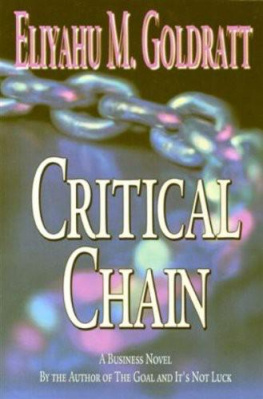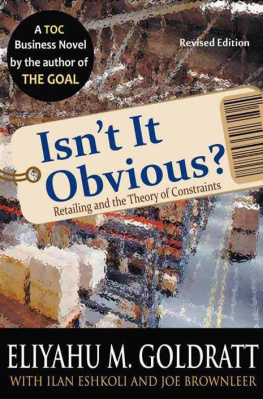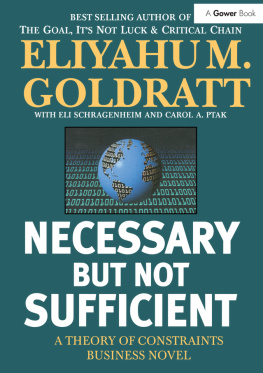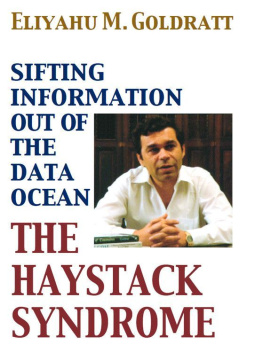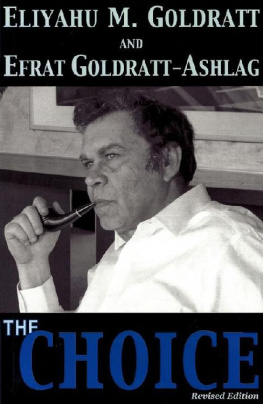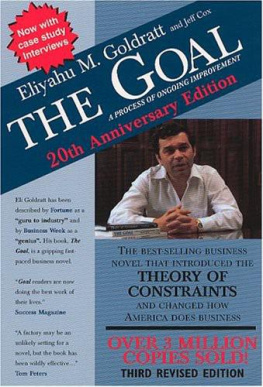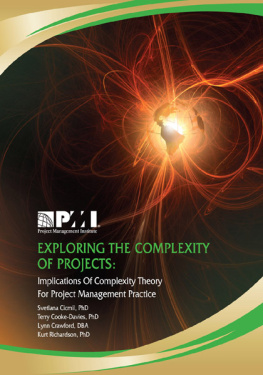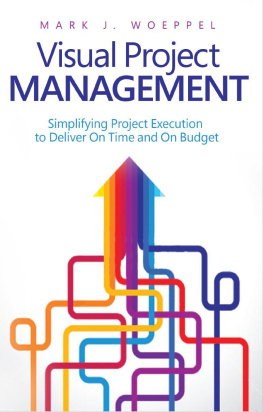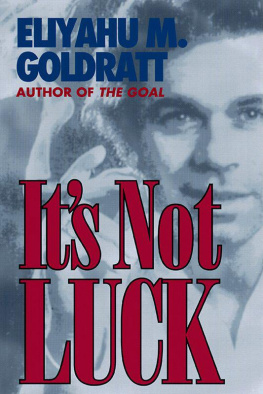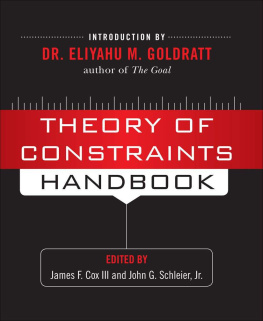OTHER BOOKS BY ELIYAHU M. GOLDRATT
The Goal
The Race
What is This Thing Called Theory of Constraints?
The Haystack Syndrome: Sifting
Information Out of the Data Ocean It's Not Luck
Eliyahu M. Goldratt
THE NORTH RIVER PRESS
Copyright 1997 Eliyahu M. Goldratt
All rights reserved. No part of this book
may be reproduced or utilized in any form
or by any means, electronic or mechanical,
including photocopying, recording, or by
any information storage and retrieval system,
without permission in writing from the
Publisher.
THE NORTH RIVER PRESS
PUBLISHING CORPORATION
P.O. BOX 567
GREAT BARRINGTON, MA 01230
(800) 486-2665
Manufactured in the United States of
America
ISBN ISBN 0-88427-153-6
Chapter 1
"This board meeting is adjourned," announces Daniel Pullman, the domineering chairman and CEO of Genemodem. The elegant conference room hums with conversation as the directors start to depart. The last quarter was the best in the history of the company. The directors are pleased, but no one is overly excited. They have come to expect it. For the past six years, almost every quarter has been better than the preceding one.
"I want to have a word with you," Pullman tells Isaac Levy, smiling and continuing to shake the hands of the external board members. When everybody else leaves they sit down.
"Have you had a chance to read McAllen's final report?" Pullman asks.
It was Levy, the executive vice-president of engineering, who had insisted on hiring a consulting firm to do an in-depth analysis of Genemodem's product development. The analysis was not restricted just to engineering, it covered the entire process. Starting with examining the way they decide on the features of a new modem, through the development process, and of no less importance, examining the way the new design is handed over to production and marketing.
Not that they had been complacent. Embarking on new technologies, new tools, even new management methods is the norm in their company. You cannot be among the leaders otherwise. Nevertheless, Levy insisted on bringing in experts from the outside. "There must be many things that we take for granted," he had claimed. "Things that only outsiders are able to see." Pullman supported him fully. Actually, no one really objected.
It was no small effort, and it did not come cheap, but at last, a week ago, they had received the four-hundred-page report.
"I really think they've done a very good job. There are many things they point out that we overlooked. We got our money's worth and then some," Levy says.
"Agreed. The report contains many good things. But I am concerned with what it does not contain. Isaac, if we were to implement everything they talk about, how much do you think our development time would shrink?"
"Hard to tell. Maybe five percent. Maybe not even that."
"That's my impression as well. So, we explored every conventional avenue and, as we expected, the answer is not there." Pullman stands up. "There is only one thing left to do. Isaac, launch the think tank."
"It's a long shot." Levy stands up as well.
"Very long, but we are skating on very thin ice." On his way out, Pullman adds, "We must find a way to rectify it. We must."
Isaac Levy looks at the three young managers sitting in front of his desk. He does not particularly like what he sees. They are not senior enough. All three are too young and too inexperienced for the task. But that was Pullman's decision.
"Isaac," he had said, "a senior person is already engraved with the way we are doing things. If there is someone who can find us a much better way, it's a young person. Young enough to be rebellious, young enough to be unsatisfied with our rules. Do you remember how young and inexperienced we were when we started? We broke every convention, and look at where we are now!"
Isaac didn't see any point in reminding him that they also "succeeded" in running their first company into the ground.
"Do you know each other?" he asks the three. "Why not introduce yourselves. Mark, you start."
"I'm Mark Kowalski. I'm with engineering."
Mark is thirty-two years old. A big man, with a voice to match. He has been with the company for eight years and recently was promoted to project leader of the A226 model. He is not the rebellious type that Pullman wanted, and Levy is not happy about risking the development of the A226, but they need a good group leader.
"Mark will be your group leader," Levy adds. "We think he is open enough to handle constructive criticism, knowledgeable and sensible enough to reject impractical criticism, and pleasant enough to ensure harmony. And if he is not, you tell me."
They are too nervous to laugh. This is the first time any of them has ever been invited to an Executive VP's office. Levy gestures to the woman to speak up.
She follows the pattern Mark used: "I'm Ruth Emerson. And I'm from marketing."
"And your job there?" Levy encourages her to elaborate.
"I'm a brand manager. I was on the team that planned the introduction of the A106."
The other two are impressed. The A106 is the current big success.
"Ruth was chosen," Levy explains, "because of her exceptional integrity. You are going to find out to what extent she is not afraid to ask questions."
"I'm Fred Romero." The last member of the group responds to Levy's look: "I'm a bean counter."
"Not exactly a bean counter," Levy laughs. "Fred is the rebel of finance. And at the same time the most respected project auditor that we have. You are all probably wondering why you are here?"
Mark and Ruth nod. Fred maintains his poker face. "From now on, you are a think tank. Your mission is to find a solution to the biggest threat endangering the future of this company."
He pauses to look directly into the eyes of each one. "Let me start by explaining the problem." Standing up, he grabs a marker and plots a curve on the white board. "Do you recognize this curve?"

"You'll find it in every textbook. It's supposed to describe the lifetime of a product. First, sales are picking up as the product is introduced into the market, then they stabilizeit becomes a mature product, and finally, it fades out. Does it fit what we know about our products?"
They believe this is a rhetorical question until he says, "Well?"
"In our case, it looks more like a triangle," Mark volunteers. "Before we finish introducing a new modem into the market, we obsolete it by launching an even newer one."
"Which doesn't make sense?" Levy questions.
"I didn't say that," Mark hurries to clarify.
"If we don't launch the new modem," Ruth comes to his aid, "our competitors will. In any event, the current modem will be obsolete. The only difference is that we'll also lose market share."
"Correct. The frantic race in the market forces us to launch a new generation of modems every six months or so."
They all nod.
"Now let me explain something that you might be less familiar with. Our company's shares trade on Wall Street for sixtytwo dollars and forty-eight cents, according to yesterday's paper. This high price is not justified by the company's assets, or even the company's profit. It is mainly based on the shareholders' expectations of future growth and future profits. Wellfounded expectations based on our impressive track record. But do you realize how fragile that is?"

